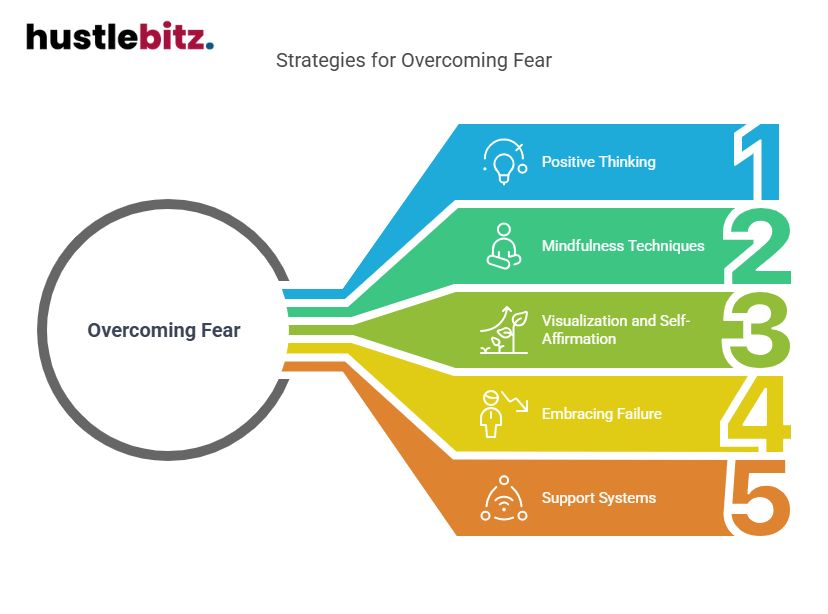Overcoming fear involves unique approaches centered on positivity and resilience. Understanding fear’s intrinsic nature is essential for developing effective strategies. Positive thinking reframes negativity, while mindfulness techniques foster present-moment awareness, reducing anxiety. Visualization and self-affirmation enhance emotional resilience by creating mental images of success. Embracing failure as an opportunity for growth allows individuals to learn from their mistakes. Strong support systems are crucial, providing encouragement and a sense of community. Furthermore, creative expression serves as a therapeutic outlet, converting fear into art. Discovering these innovative methods can transform how one confronts and navigates their fears.
Key Takeaways
- Positive thinking reframes challenges as opportunities, empowering individuals to confront fear and dismantle negative thought patterns.
- Mindfulness techniques, such as mindful breathing and gratitude practice, promote resilience and reduce anxiety in the face of fear.
- Visualization and self-affirmation create mental imagery of success, reinforcing belief in capabilities and aiding in habit formation.
- Embracing failure as a growth opportunity fosters resilience, turning setbacks into valuable learning experiences.
- Support systems, including community connections and accountability partners, enhance emotional resilience and encourage taking action against fear.

Understanding the Nature of Fear

Fear, an intrinsic emotional response to perceived threats, serves as a fundamental aspect of human experience that can significantly influence behavior and decision-making. Understanding the biological origins of fear reveals its evolutionary significance, as it has been crucial for survival. The amygdala, a key brain structure, triggers fear responses that prepare the body for fight or flight, impacting not only immediate reactions but also long-term psychological health.
The psychological impact of fear extends beyond mere survival instincts; it can paralyze ambition and stifle potential. In a world that rewards decisiveness and resilience, fear can be a formidable adversary, impeding individuals from seizing opportunities. Effective fear management strategies are essential for those seeking power, enabling them to harness fear as a motivating force rather than a debilitating one.
Moreover, cultural influences shape how fear is perceived and managed, with societal norms dictating acceptable expressions of fear and courage. Different cultures may valorize certain fears—such as fear of failure—or downplay others, leading to diverse approaches to overcoming fear. Recognizing these cultural nuances is vital for leaders and influencers who aim to cultivate environments where fear is acknowledged yet transformed into a tool for empowerment.
The Power of Positive Thinking
Harnessing the potential of positive thinking can serve as a powerful antidote to the paralyzing effects of fear, enabling individuals to reframe their mindset and approach challenges with confidence and resilience. By cultivating an affirmative mindset, one can shift focus from the limitations imposed by fear to the possibilities that lie ahead. This shift is not merely wishful thinking; it is an intentional practice that fosters an optimistic outlook, empowering individuals to confront obstacles head-on.
Cognitive reframing plays a crucial role in this transformative process. By challenging negative thought patterns and replacing them with constructive narratives, individuals can dismantle the mental barriers that fear erects. This practice enhances resilience building, allowing one to bounce back from setbacks with renewed vigor and determination. Self-empowerment strategies such as setting achievable goals and celebrating small victories further reinforce this positive mindset, creating a feedback loop that bolsters confidence.
Moreover, the act of consciously engaging in positive thinking equips individuals with the tools needed to navigate uncertainty and adversity. When faced with daunting challenges, the ability to maintain an optimistic perspective can be the differentiator between stagnation and growth.
Ultimately, the power of positive thinking is not just about feeling good; it is about reclaiming agency in the face of fear and harnessing one’s inherent strength to forge a path forward. In this way, positive thinking becomes an essential ally in the pursuit of courage and personal achievement.
Mindfulness Techniques for Courage

Mindfulness techniques can significantly enhance courage by promoting self-awareness and emotional regulation, enabling individuals to confront their fears with greater clarity and composure. By focusing on the present moment, individuals can cultivate a mindset that embraces challenges rather than shying away from them. Essential practices such as mindful breathing, body awareness, and gratitude practice serve as powerful tools in this transformative journey.
The table below highlights key mindfulness techniques and their impact on courage:
| Mindfulness Technique | Description | Impact on Courage |
| Mindful Breathing | Focused breathing to calm the mind | Reduces anxiety and enhances focus |
| Body Awareness | Tuning into bodily sensations | Promotes resilience and presence |
| Present Moment | Engaging fully with the here and now | Diminishes fear of the unknown |
| Gratitude Practice | Acknowledging positives in life | Fosters positivity and self-compassion |
Incorporating self-compassion into these practices further amplifies their effectiveness. By treating oneself with kindness during moments of fear, individuals cultivate a supportive internal dialogue that emboldens them to face adversity. The synergy of these mindfulness techniques cultivates a robust foundation for courage, allowing one to navigate life’s uncertainties with poise and determination. As individuals learn to harness these strategies, they not only overcome their fears but also embrace their true potential, emerging more powerful and resilient than ever.
Visualization: Imagining Success

Building on the foundation of self-awareness established through mindfulness techniques, visualization serves as a powerful tool for imagining success and overcoming obstacles. By engaging in this practice, individuals can create vivid mental images of their desired outcomes, thereby enhancing their goal-setting efforts.
Visualization acts as a form of mental rehearsal, allowing individuals to simulate success scenarios, which in turn fosters emotional resilience when faced with real-life challenges. The process of visualization enables the formation of positive habits, as repeated mental imagery reinforces neural pathways related to success.
This practice not only prepares the mind for achievement but also cultivates a steadfast belief in one’s capabilities through self-affirmation. By affirmatively imagining positive outcomes, individuals bolster their confidence and reinforce their commitment to their objectives.
Moreover, visualization can be strategically integrated into daily routines, transforming it into a powerful habit formation tool. Regularly envisioning success equips individuals with the mental framework needed to navigate obstacles and setbacks, ultimately enhancing their capacity to maintain focus and motivation.
This proactive approach to overcoming fear empowers individuals to harness their mental faculties, directing them toward their desired results.
Embracing Failure as Growth
Embracing failure as a crucial component of personal growth allows individuals to reframe setbacks as opportunities for learning and development. By adopting a growth mindset, one can transform the traditional failure mindset into a powerful catalyst for resilience building. Rather than viewing failure as an endpoint, it becomes a stepping stone toward greater achievements.
To cultivate this transformative perspective, consider the following strategies:
- Embracing Vulnerability: Acknowledge the inherent risks and uncertainties that accompany any endeavor. This acceptance fosters an environment where authentic learning can occur.
- Identifying Learning Opportunities: Reflect on failures to extract valuable insights that inform future decisions. Each misstep can reveal essential lessons about strategies and approaches that may need adjustment.
- Reinforcing Resilience: Develop the mental fortitude to bounce back from setbacks. This resilience not only strengthens character but also enhances the ability to face future challenges with increased confidence.
Incorporating these principles into your daily life empowers you to view failures not as detriments but as essential elements of your journey. By shifting focus toward growth, it becomes possible to unlock untapped potential and navigate the complexities of life with a renewed sense of purpose.
Ultimately, embracing failure fosters an environment rich in learning opportunities, allowing individuals to thrive in the face of adversity and emerge stronger than ever before.
The Role of Support Systems

How significantly do support systems influence an individual’s ability to overcome fear and foster a positive mindset?
The presence of a robust support system can be a transformative force in cultivating emotional resilience. Individuals who engage with a network of supportive peers are more adept at navigating their fears, as these connections provide not only a safety net but also a platform for growth.
Community connection plays a pivotal role in reinforcing the belief that one is not alone in facing challenges. This sense of belonging fosters a culture of shared experiences, where individuals can draw strength from collective narratives.
Additionally, accountability partners serve as crucial allies, motivating individuals to push beyond their comfort zones. They offer structured frameworks for progress, ensuring that goals are met while instilling a sense of responsibility.
Encouragement strategies employed within support systems can amplify an individual’s capacity to confront fears. Simple affirmations, constructive feedback, and shared resources foster an environment where positivity thrives.
Social support, whether through friends, family, or professional networks, is vital in mitigating the paralyzing effects of fear, transforming it into a catalyst for action.
Creative Expression as Therapy

Creative expression serves as a powerful therapeutic tool, enabling individuals to channel their emotions and confront fears in a constructive manner. Engaging in various forms of creative expression not only fosters resilience but also empowers individuals to reclaim their narratives.
Art therapy, for instance, allows participants to visualize their emotions, transforming abstract fears into tangible artwork. This visual representation can serve as a catalyst for deeper reflection and understanding.
Consider the following modalities of creative expression:
- Music expression: Whether through songwriting or instrumental play, music provides a universal language that can articulate feelings that words often fail to capture.
- Dance movement: This physical form of expression encourages the release of pent-up emotions and cultivates a sense of freedom, promoting self-acceptance and body positivity.
- Creative journaling: Utilizing writing prompts, individuals can explore their thoughts and fears in a structured format, facilitating an insightful dialogue with oneself.
The integration of these creative avenues not only aids in processing fear but also enhances emotional intelligence, ultimately leading to personal growth.
By embracing the transformative power of creative expression, individuals can dismantle the barriers that fear erects, paving the way for a more empowered existence.
Thus, embarking on this journey of self-exploration through art, music, dance, and writing serves not only as a therapeutic endeavor but as a declaration of resilience and courage in the face of adversity.
Final Thoughts
Overcoming fear through positivity requires a unique blend of self-awareness, emotional resilience, and proactive strategies. By leveraging techniques such as positive thinking, mindfulness, and visualization, individuals can transform fear into a catalyst for growth. Embracing failure as a learning opportunity, surrounding oneself with a supportive network, and using creative expression as an emotional outlet all contribute to building courage. These approaches empower individuals to confront fear head-on and emerge stronger, more resilient, and better equipped to navigate life’s challenges. Finding courage is not about avoiding fear, but about learning to face it with confidence and optimism.




